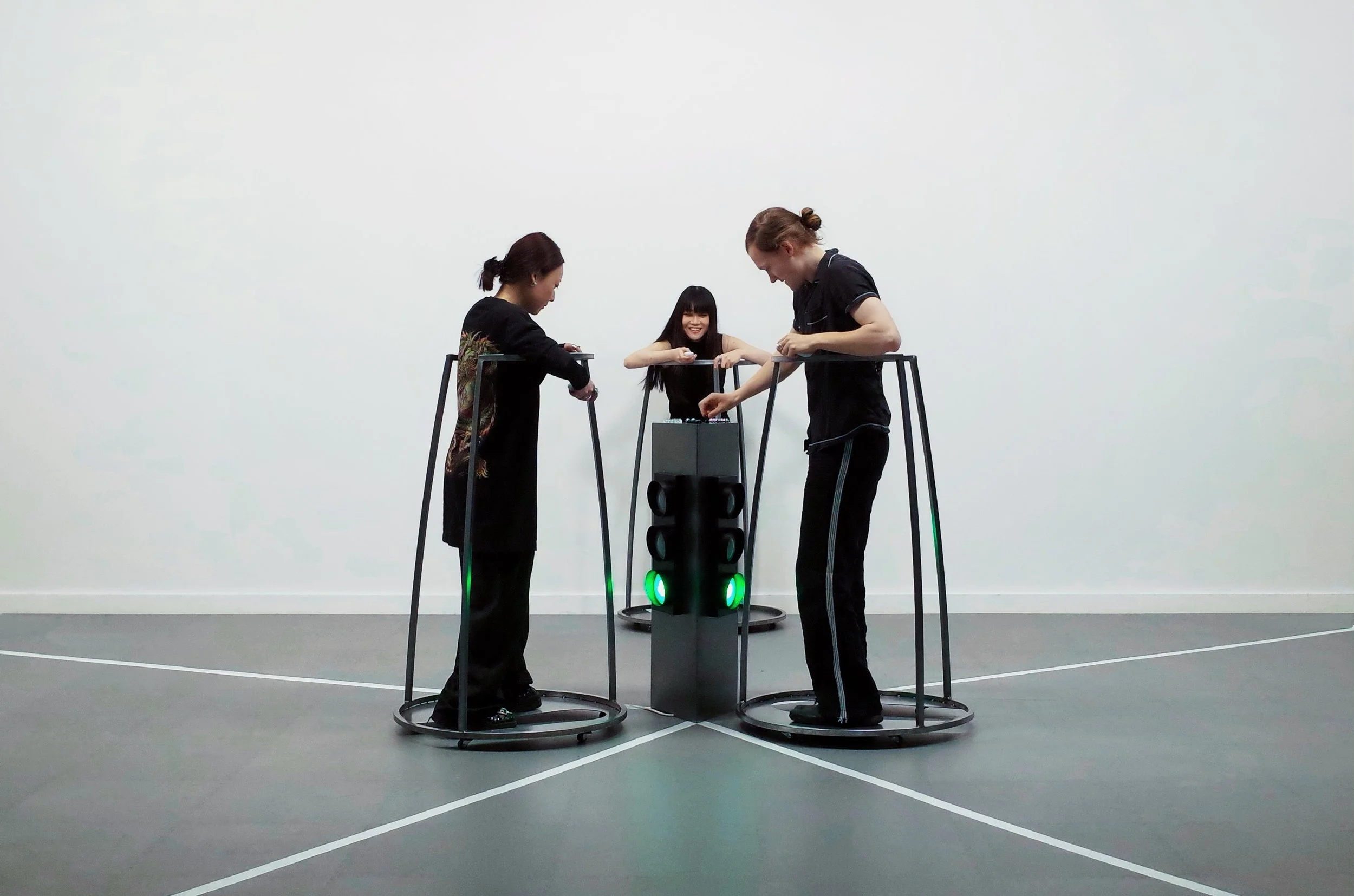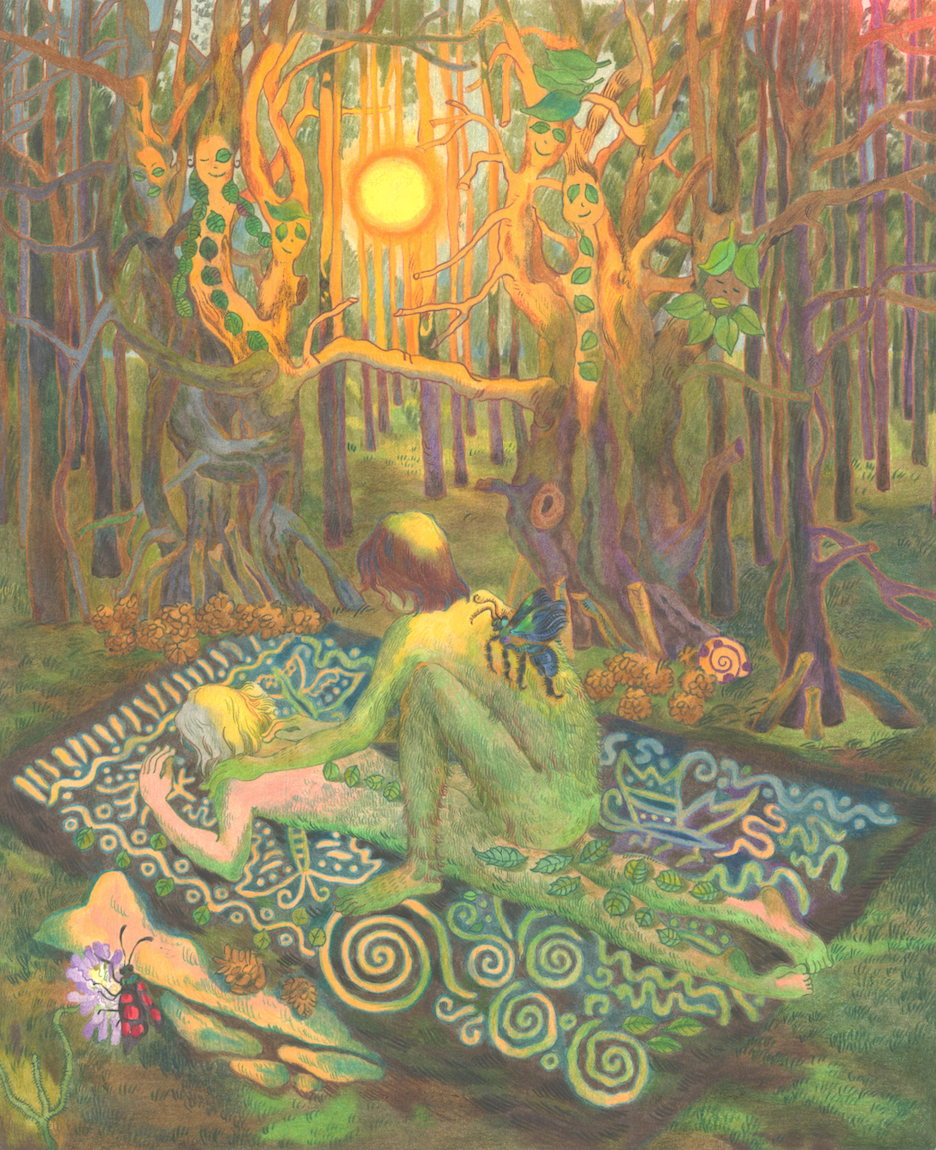10 Questions with Sarah Fuentes
Sarah Fuentes is a Colombian visual artist whose work unfolds at the crossroads of body, image, and technology. With a background in animation and a strong interest in movement, she creates visual experiences that are both sensory and reflective. Her practice includes interactive installations, multimedia performances, and audiovisual pieces that explore how the human body and perception are transformed in hybrid, digitally mediated environments.
Combining analogue materials and digital tools, she engages in collaborative and experimental processes to investigate the blurred boundaries between the physical and the virtual.
Sarah Fuentes - Portrait
ARTIST STATEMENT
Sarah understands the image not as a static representation of an idea but as a living experience—connected to the body and activated or transformed through movement, space, and technology. She is interested in how the intersection of the visual and the corporeal reshapes the way we perceive ourselves and inhabit the world, both physically and digitally.
Her work emerges from the dialogue between the organic and the artificial, the human and the digital. Through hybrid processes that may involve tactile materials, animation, interactive visuals, or performative elements, she creates experiences that don’t aim to deliver answers but to open questions. Rather than conveying fixed messages, her pieces seek to recognize sensitive aspects of human experience and offer a doorway into new ways of seeing, feeling, and being in a world increasingly shaped by technology.
CREA, Interactive Performance, 3x2m, 2024 © Sarah Fuentes
INTERVIEW
First of all, tell us a bit about your background. How did your background in digital art and movement shape your artistic practice?
I come from a background in visual arts, with a focus on animation. From the very beginning, the body was essential to my creative process — always used as a reference for movement, gesture, and emotion. But what fascinated me most wasn't just using the body to mimic reality; it was how expressive and meaningful it could be on its own.
That curiosity led me to shift my focus: instead of keeping the body behind the scenes as a mere reference, I began exploring it as a central element of my work. I started integrating animation with live-action footage and later moved into creating interactive projects where the physical body and the digital realm merge directly. For me, the intersection between human presence, movement, and digital media opens up powerful possibilities for storytelling.
What first inspired you to explore the relationship between the human body and technology?
My inspiration came from realizing how the body is not just a tool for representation, but a powerful medium of expression and experience. I was fascinated by how technology can extend and transform our physical presence, creating new ways to communicate and interact. This curiosity pushed me to explore projects where the body and technology don't just coexist but become inseparable—where digital elements respond to and amplify the subtle movements and emotions of the human form. For me, this relationship opens up exciting possibilities for rethinking identity, connection, and creativity in the digital age.
KATAA, Interactive Installation, Full dome, 2024 © Sarah Fuentes
Can you describe the creative process behind your interdisciplinary projects?
My creative process can vary depending on the type of project and format, but generally, it always starts with an idea that emerges from a casual moment or a lived experience. I like to write about this idea, explore related research, thoughts, and concepts, and begin connecting them. During this phase, I start to visualize glimpses of how the project could look or be executed.
Once I have a clearer idea of what I want to explore and how, I move into a phase of experimentation and testing, trying out different approaches to see what works best. While some core elements remain constant throughout the process, I believe many other parts evolve and adapt alongside me as the project develops.
Finally, after refining the concept, I enter the production and development phase, which leads to assembling the final piece—whether it's an exhibition, a recording, or another form of presentation.
How do you use real-time visuals to enhance performances like C.R.E.A: El viaje del artista?
In this era, I believe real-time visuals are almost as essential as the performance itself. They don't just decorate the stage — they contribute, complement, and sometimes even expand the narrative by offering additional layers of meaning, almost like hidden messages under the surface.
In C.R.E.A, for example, I used real-time visuals that reacted to the movements of the dancer. This created a dialogue between the physical and the digital, making the visuals feel alive, like they were breathing with the performer. That organic interaction gives the audience a sense of something living, even within the digital. It's a powerful and beautiful relationship that I love to explore — where technology doesn't replace the human, but extends and echoes it.
C.R.E.A, El Viaje Del Artista, Interactive Performance, 3x2m, 2024 © Sarah Fuentes
C.R.E.A, El Viaje Del Artistas, Interactive Performance, 3x2m, 2024 © Sarah Fuentes
What challenges do you face when merging physical movement with digital art?
One of the biggest challenges lies in the coordination and production of both worlds. Physical movement and digital tools often come from very different places — one is rooted in the human, the organic, the emotional; the other in technology, precision, and cold logic. Bridging these opposites requires careful exploration and testing.
Finding the right tools — sensors, software, or interfaces — and configuring them in a way that responds meaningfully to the body can be technically demanding. But beyond the tech, the artistic challenge is ensuring that neither the digital nor the physical overwhelms the other. I aim for both elements to feel cohesive, to enhance each other, and to work together toward the conceptual core of the piece.
How do you want audiences to feel when experiencing your immersive works?
More than guiding them toward a specific feeling, what I truly hope is to open something in their minds — like a small internal explosion or a sudden shift in perspective. I want them to feel a spark of possibility, as if a window had opened to something they hadn't considered before.
If the experience stays with them somehow — if it leaves a trace, sparks a question, or invites them to see that there are many paths to explore — then I feel the work has done its job. It's not about being grand or profound; it's about connecting, gently disrupting, and inspiring them to imagine, question, and create their own unique journey.
In what ways do you think technology is changing the boundaries of artistic expression?
Honestly, I see technology as an extension of the human body — a tool that has become part of us. It makes many creative processes easier and opens the door to many new forms of artistic expression.
Technology breaks down the traditional boundaries between different art forms, which used to feel separated or even opposed. Now, it works like a bridge that connects these areas, allowing new ways of creating and expressing.
Beyond that, technology is transforming how we experience and live art. It's removing the boundaries between the audience and the artwork, making the relationship more interactive and immersive. This shift changes art from something distant into a living, dynamic exchange.
In this way, technology not only extends human creativity but also invites us to imagine and create new artistic languages, expanding how we see, create and feel art.
Sin Rostro, Video dance, 1920x1080 px, 2023 © Sarah Fuentes
Sin Rostro, Video dance, 1920x1080 px, 2023 © Sarah Fuentes
What role does spontaneity play in your work, given the mix of movement and digital media?
Spontaneity plays a big role in my work — I'd say it's a 50/50 balance. There's always room for improvisation, exploration, and uncertainty, which I think is essential when working with movement and digital media. That freedom allows us to find unexpected results, moments that surprise us or open new directions we hadn't considered. It's a way to connect deeply with the process and let the work grow organically.
Even when the work moves into the production phase — especially with the technical aspects — spontaneity doesn't disappear. There are certain limits that come in, like spatial constraints or how movement interacts with the digital tools, but I don't see them as rigid restrictions. Instead, they shape the way spontaneity shows up. It's still there, just more focused or contained — and sometimes, working within those limits can even lead to powerful results.
Which artists or disciplines have influenced your approach to audiovisual art?
My initial entry point into audiovisual art was through animation — learning how to bring images to life, understandingrhythm, timing, and visual language. It taught me to shape emotion and narrative through motion. Over time, however, I began to see animation not just as a tool for storytelling, but as a way to think and feel in motion rather than simplyillustrate a script. That shift opened a much more personal and experimental space for me.
This evolution brought me closer to interdisciplinary and performative fields, where audiovisual art becomes somethingmore alive and integrated. A pivotal moment was experiencing HYBRIS by La Quinta del Lobo, a Colombian transmedia ensemble. That work blended visuals, sound, live music, voice, and the physical presence of performers in a way I had never seen before. It was the first time I clearly saw the potential of audiovisual language as something immersive and living — not just supporting a performance, but being part of the performance itself.
Another strong influence was the artist Renzo Rospigliosi, whose work merges audiovisual creation with physical presence and theatricality. His pieces showed me how audiovisual art can exist on stage as a protagonist, not just a backdrop. Beyond technique, Renzo also impacted how I approach my creative path: he made me realize that imagining something is already a form of action — that the creative impulse carries within it the potential to become real. That exploration and intuition are not distractions, but essential parts of the artistic process. This mindset encouraged me to trust my instincts, embrace the unknown, and believe in what I do — and what I will do.
Working with artists from different disciplines — from dancers to musicians, coders, and sound designers — has also deeply enriched my work. These collaborations have shaped not just the development of specific pieces, but also my growth as an artist. Each exchange has expanded my perspective, showing me new ways of thinking, listening, and creating.
Artist’s Talk
Al-Tiba9 Interviews is a promotional platform for artists to articulate their vision and engage them with our diverse readership through a published art dialogue. The artists are interviewed by Mohamed Benhadj, the founder & curator of Al-Tiba9, to highlight their artistic careers and introduce them to the international contemporary art scene across our vast network of museums, galleries, art professionals, art dealers, collectors, and art lovers across the globe.





















